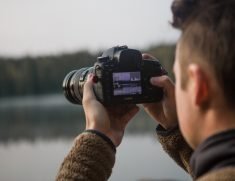Last updated on December 7th, 2023
When taking high-quality photos or videos, the right technology plays an important role. Two camera technologies are IBIS (in-body image stabilization) and OIS (optical image stabilization). In this blog post, we will discuss the differences between them so that you can make an informed decision when selecting one.

IBIS stands for “in-body image stabilization” and refers to a system of gyroscopes and sensors embedded inside a camera body that helps counteract any random movements of the lens or camera body when taking pictures at slow shutter speeds or longer focal lengths. These gyroscopes sense any vibration in the camera, providing automatic corrections that help create sharper images with less distortion or noise.
Meanwhile, OIS stands for “optical image stabilization” and is a technology applied directly to lenses rather than on camera bodies. This involves adding tiny motors within individual lenses, which help compensate for any shake or vibration, allowing light to enter through specific points of an optical path more steadily and consistently than it would otherwise. This helps reduce blurriness from shots taken at slow shutter speeds or with long focal lengths.
Both IBIS and OIS systems have advantages and downsides depending on your needs, so it is important to weigh them carefully as you decide which is best suited for your project.
Differentiating Ibis and OIS
Inbody image stabilization (IBIS) and Optical Image Stabilization (OIS) are similar technologies cameras use to capture higher-quality photos and videos. But, despite the similarities, there are some critical differences between them.
Let’s begin. With IBIS, you get embedded gyroscopes and sensors within the camera body that work together to banish blurring or noise caused by shaky hands while taking photos with long shutter speeds or focal lengths. This stabilization system contains up to 5 axes: X, Y, Roll, Yaw, and Pitch. Not only does this reduce distortion in your images – without a tripod – it also makes photography much more convenient for those on-the-go moments!
OIS, on the other hand, stabilizes any captured image by adjusting the optical path to the sensor. This technology is embedded in your lens; it allows light to pass through specific points of an optical path more securely and steadily than if this technique was not used. Consequently, blurriness from shots taken at slow shutter speeds or long focal lengths can be reduced significantly when utilizing OIS.
The main difference between IBIS and OIS lies in their technology: while IBIS uses sensors and gyroscopes embedded in camera bodies, OIS applies optical technology directly to lenses. Moreover, IBIS works best when taking pictures by hand, while OIS is better suited for sharper images where blur or noise would otherwise be produced when a camera takes pictures at slower shutter speeds or with long focal lengths.
Advantages and Disadvantages of Ibis
Camera-based image stabilization has some unique advantages over lens-based image stabilization. It can stabilize an image even when a lens without built-in stabilization is used, reducing the weight and complexity of the lenses. Additionally, when sensor-based image stabilization technology improves, it only requires replacing the camera to take advantage of improved performance.
It is typically much less expensive than replacing all existing lenses if relying on lens-based image stabilization. Some sensor-based systems can also correct for camera roll rotation that can occur when pressing the shutter button, something that a lens-based system cannot do.
Although camera-based image stabilization can be beneficial, the disadvantage is that it does not appear in the viewfinder. This could cause difficulty on cameras with optical viewfinders, as opposed to electronic ones, since they project images directly from their sensors. Additionally, if a phase detection autofocus system isn’t connected to the sensor, there won’t be any benefits.
In-body image stabilization necessitates a giant output picture circle from the lens due to the mobility of its sensor during exposure, consuming more of the image.
Distinctively different than lens movements in optical image stabilization systems, sensor motions are much larger and reduce effectiveness as they have a confined range. As focal length increases, so does the speed and scope needed for movement, making it less ideal for long telephoto lenses and slower shutter speeds since it would not suffice with the limited motion capacity available on a given sensor.
Today, many fantastic IBIS offerings are out on the market. From beginner-level options like Panasonic Lumix GX850, which leverages 5-axis Dual IS 2 image stabilization – combining both lens and in-body sensors – to more sophisticated models, including Sony Alpha 7 III featuring 5-axis sensor-shift IS technology for amazingly stabilized footage even when recording 4K video clips.
Advantages and Disadvantages of OIS
Optical image stabilization (OIS) is a valuable technology that makes it easier to take high-quality pictures with digital cameras, especially handheld ones. It works by countering any shaking motion when recording videos, helping to reduce motion blur and making it possible to capture images more accurately. Moreover, it also helps with autofocus in low-light conditions and reveals more detail with optical viewfinders.
However, this technology does come with some drawbacks and limitations. On the financial side, OIS can be expensive because it requires separate systems for individual lenses. Not all lenses have this feature, such as fast primes and wide-angle lenses. Furthermore, OIS cannot address rotation along the optical axis, limiting its ability to handle specific movements.
Compared to IBIS (in-body image stabilization), OIS is less effective. This is because ibis uses sensors within the camera body that detect movement and adjusts accordingly. Ibis can work with all lenses, regardless of the type. Ibis generally provides better overall stabilization and can address rotation along the optical axis. IBIS also offers more options for customization, such as level of stabilization, angle-of-view adjustment, and more.
Conclusion Difference between IBIS and OIS
Photographers should consider the advantages and disadvantages of both in-body image stabilization (IBIS) and optical image stabilization (OIS). IBIS relies on sensors within the camera body to reduce distortion, noise, and weight but cannot autofocus. OIS requires adding motors into lenses that can offset shake or vibration but are often pricier than its alternative and have more limited rotational capabilities. Opting for IBIS may be wiser due to its higher performance and lower cost.
FAQ: IBIS vs OIS
Can I have both?
Yes, you can have both ibis and ois in a camera system. Camera systems today often come with both In-Body Image Stabilization (IBIS) and Optical Image Stabilization (OIS). IBIS is integrated into the camera’s body, making it an excellent option for capturing images in low light conditions or when shooting handheld. OIS technology is built into some camera lenses to help reduce the effects of blur and camera shake, allowing photographers to take sharper photos even in challenging environments. Combined, these two image stabilization options provide an added level of control and flexibility that can improve the quality of your photography.
Are ibis and ois the same?
No, Ibis and OIS are two different types of image stabilization technology. IBIS is an in-body image stabilization system that uses sensors within the camera to reduce distortion and noise. At the same time, ois requires adding motors into lenses that can offset shake or vibration.
Which system should I use for my photography?
The best option for your photography will depend on what kind of shots you want to take and what type of equipment you have available. Having both IBIS and OIS may be the best choice if you want more flexibility. However, if budget or weight is an issue, choosing either can provide excellent results depending on your needs.


